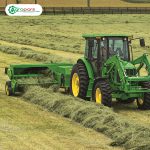Cubic baler:
A cube baler is one of the most widely used devices in modern agriculture, used to collect, compress, and package fodder, straw, and other agricultural residues into regular cubes. This device, using mechanical and hydraulic mechanisms, performs the packaging process automatically and efficiently, and plays an important role in increasing farm productivity. In this article, we will examine how a cube baler works, its main components, and its operating stages.
Main components of a cubic baler
Pick-up unit
The cubic baler is equipped with a collecting unit located at the front of the machine. This unit is responsible for collecting the forage or straw scattered on the ground. The collecting unit uses metal or plastic tines to pick up the material from the ground and direct it into the machine. The height of this unit can be adjusted depending on the field conditions and the type of crop.
Compression Chamber
The compression chamber is the heart of the cubic baler. In this section, the collected forage is compressed by a piston into regular cubes. The piston, with its reciprocating motion, compresses the material in layers until it reaches the desired size.
Knotting System
After compression, the packages must be tightly tied to maintain their shape. A tying system uses thread or wire to tie the cube packages. This system usually includes needles and tyers that operate automatically and ensure that the packages do not open during transport and storage.
Ejection System
After the packages are tied, they exit the machine through a discharge system. This system usually includes a ramp or ejection mechanism that transfers the packages to the ground or directly to a wagon attached to the machine.
Cubic baler operating steps
Step 1: Collecting Fodder
In the first stage, a cube baler, usually attached to a tractor, moves through the field. The collecting unit collects loose material, such as straw or hay, from the ground and sends it into the machine. This stage requires great precision to prevent stones or unnecessary objects from entering the machine.
Step 2: Transfer to the compression chamber
After collection, the forage is transferred to the compression chamber. In this section, a piston compresses the material using hydraulic or mechanical pressure. This process is carried out gradually, with each new layer being added to the previous layers until the package reaches a certain size.
Step 3: Packaging and Tying
When the package reaches the desired size, the knotting system is activated. The machine’s needles wrap the thread or wire around the package, and the knotters tighten it. This step is very sensitive, because if the knots are not tied properly, the packages may open in the next steps.
Step 4: Unpacking the packages
Finally, the prepared packages are discharged from the machine through the discharge system. The packages are either placed directly on the ground or transferred to a wagon attached to the baler to be prepared for storage or transportation.
Important points in the operation of the cubic baler
Device settings
For optimal performance, machine settings must be adjusted to the crop type and field conditions. For example, bale density, bale length, and even the height of the collector unit must be adjusted accordingly.
Maintenance and service
Because the cubic baler operates in harsh farm conditions, it requires regular maintenance. Checking the knotting system, lubricating moving parts, and cleaning the collection unit are some of the measures that extend the life of the machine.
Conclusion
The cube baler, with its precise and efficient mechanism, is one of the essential tools in modern agriculture. By collecting, compressing, and packaging fodder into neat cubes, this device not only makes farmers’ work easier, but also helps increase productivity and reduce waste. Understanding how this device works and paying attention to its maintenance can ensure its long-term and effective performance in the fields. If you plan to use a cube baler, paying attention to its settings and regular service is the key to success.





